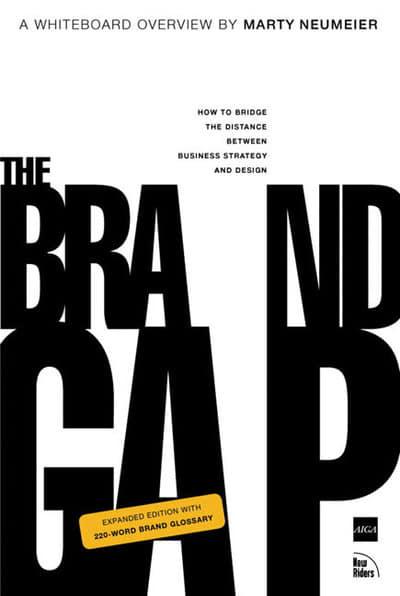The Brand Gap is a great, quick book by Marty Neumeier that helps explain how to build a personal or company brand and how to manage it over time. I read this book on my Kindle app on my iPad. It can be read in just a few hours. It’s a nice 30,000-foot view and includes a really handy glossary of terms and a concluding section that sums it all up as “take-home lessons.”
As he emphasizes right from the start and sums up in the conclusion of the book, “A brand is not a logo. A brand is not a corporate identity system. It’s a person’s gut feeling about a product, service, or company. Because it depends on others for its existence, it must become a guarantee of trustworthy behavior.”
The Brand “Gap” is what you think your brand is and what it is perceived by others to be. And, every single person may have a slightly different view of your brand. While that’s ok to some extent, there are ways to bridge that gap through brand management.
He divides the book into five disciplines that he tries to teach: (1) Differentiate (2) Collaborate (3) Innovate (4) Validate, and (5) Cultivate.
Differentiate: Who are you? What do you do? Why does it matter? “An unfocused brand is one that’s so broad that it doesn’t stand for anything. A focused brand, by contrast, knows exactly what it is, why it’s different, and why people want it,” says Neumeier. “Yet focus is difficult to achieve because it means giving something up.”
Collaborate: Brands don’t develop in isolation. It takes a village to build a brand. He outlines three of the basic models for managing brand collaboration: (1) The one-stop shop – one person within the client company directs the entire brand effort; (2) The brand agency – where the client works with a lead agency, which helps assemble a team of specialist first to work on the brand; and (3) The integrated marketing team, which sees branding as a continuous network activity that needs to be controlled from within the company. Each of these models have strengths and weaknesses and should be tailored for your specific needs. These are messier in practice and many companies are mixing and matching aspects of all three models.
Innovate: “Innovation requires creativity, and creativity gives many business people a twitch,” says Neumeier. “Anything new, by definition, is untried, and therefore unsafe.” However, you can’t be a leader by following. However, “all brand innovation, whether for a website, a package, a product, an event, or an ad campaign, should be aimed at creating a positive experience for the user.”
Validate: All real-world communication is a dialog. Testing, or validation, is the process of measuring brands against meaningful criteria. All brand expressions, from icons to actual products, need to score high in five areas of communication: (1) distinctiveness, (2) relevance, (3) memorability, (4) extendibility, and (5) depth.
- Distinctiveness is the quality that causes a brand expression to stand out from the crowd.
- Relevance asks whether a brand is appropriate for its goals.
- Memorability is the quality that allows people to recall the brand or brand expression when they need to.
- Extendibility measures how well a given brand expression will work across media, across cultural boundaries, and across message types.
- Depth is the ability to communicate with audiences on a number of levels.
Cultivate: “When the external actions of a company align with its internal culture, the brand resonates with authenticity,” says Neumeier. “The secret of a living brand is that it lives throughout the company, not just in the marketing department” and “the long-term success of any brand depends on the constant regeneration of corporate memory.”

